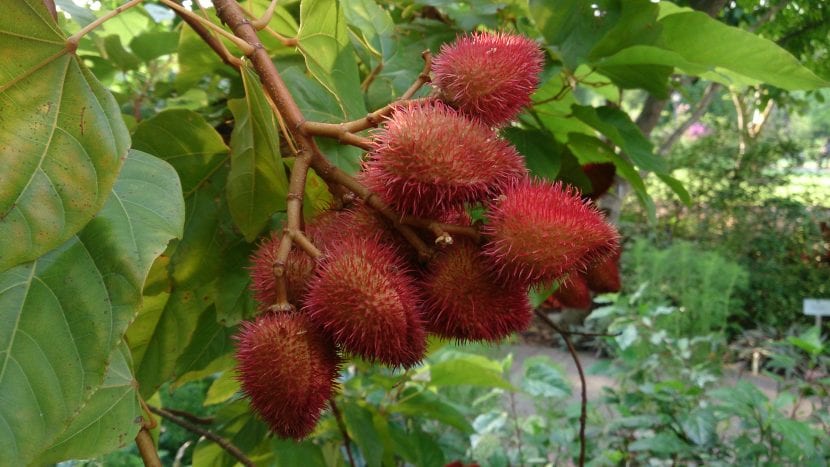
Achiote is a very complete plant: it has a very great ornamental value, since it can also be grown indistinctly both in pot and in soil, it is medicinal and culinary. Apart from that, its care is simple and its multiplication fast.
What more could you want? A token that tells you everything about him? Well there it goes. 😉
Origin and characteristics of achiote
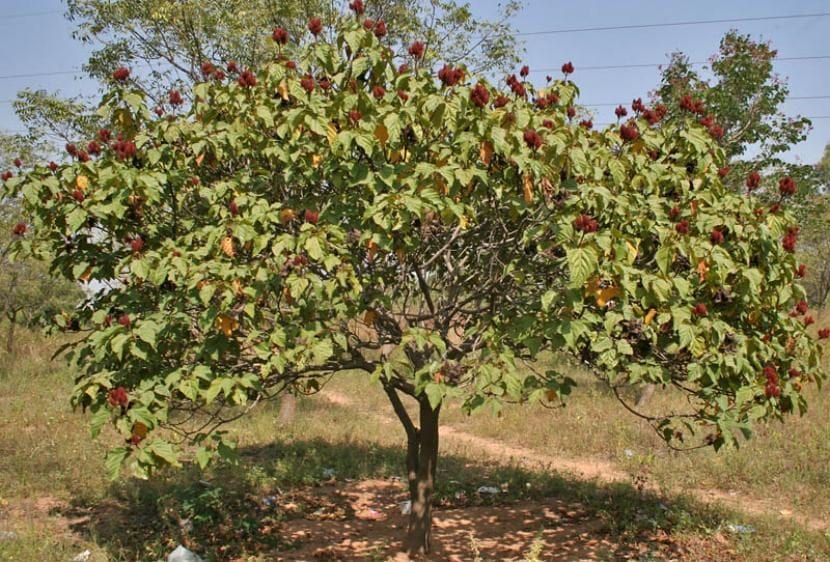
Our protagonist is an evergreen shrub native to the intertropical regions of America whose scientific name is bixa orellana. Since that name probably doesn't tell you anything, I'm going to tell you what it's commonly called: açafroa, urucú, onoto, bija, benis and of course achiote. It reaches a height of 2-4 meters, being able to reach 6m. Its crown is low and extended, and its trunk is brown. It branches low above the ground.
The leaves are simple, large (6-27 x 4-19cm), with smooth, petiolate, green margins. The flowers appear in terminal clusters of panicles, 5-10 cm long, and are hermaphroditic., that is, it has male parts (stamens) and female parts (stigma and ovules with ovaries). These are pinkish or whitish, depending on the variety, and measure 3 to 6cm in diameter.
The fruit is a red capsule, 2 to 6cm long, covered by thick and spiny hairs, dark greenish to purple depending on the variety. When ripe, it turns dark reddish brown. In each valve there are seeds in number from 10 to 50. Each of them is compressed, 5mm long.
How do you take care of yourself?
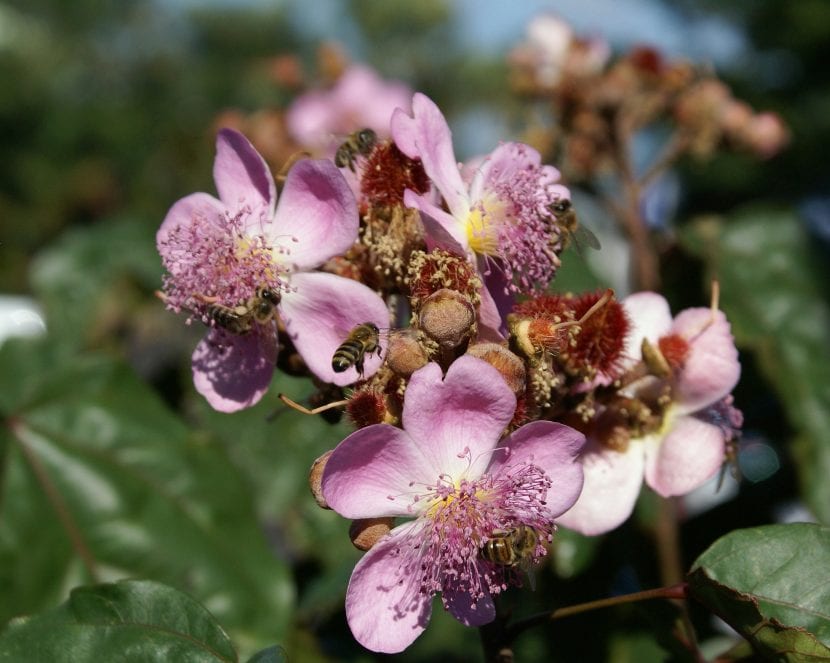
Do you want to get one and take care of it in the best possible way? Follow our advice:
Location
Achiote is a plant that it has to be placed outside, either in full sun or in semi-shade. In climates where frosts occur, during autumn-winter it must be or indoors in a very bright room, or in a greenhouse or protected with plastic in order to protect it from low temperatures.
Soil or substrate
Not very demanding. It grows well in all types of soils, but if it is grown in a pot we recommend using a substrate that has good drainage, such as black peat mixed with perlite so that it can root better.
Irrigation
Watering should be frequent in summer, every 3-4 days. The rest of the year, you have to water it 2 or 3 times a week, avoiding waterlogging. If it is kept in a pot with a plate underneath, the excess water must be removed ten minutes after watering.
The best water to irrigate is always the rain, but if we cannot get it, we will fill a container with tap water and let it stand overnight before using it.
Subscriber
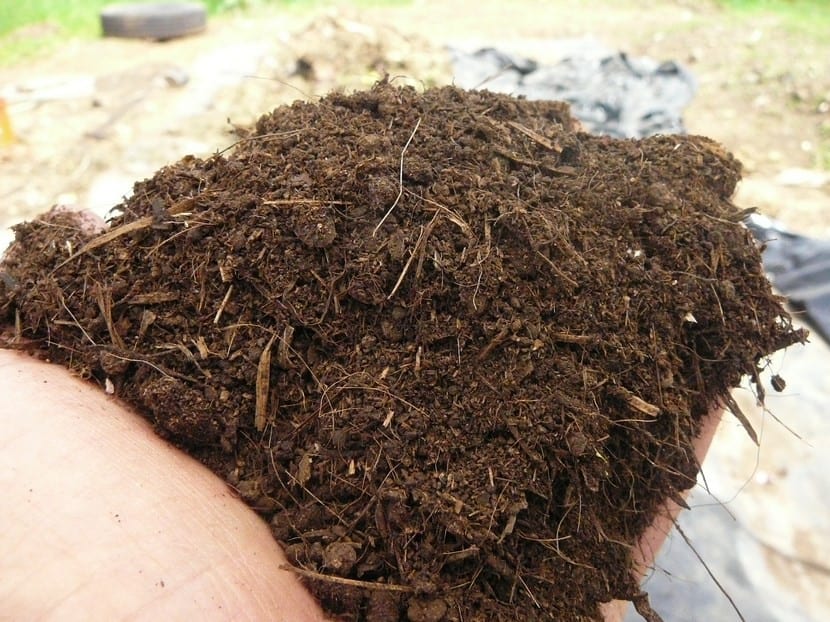
As it is a plant whose fruits are suitable for human consumption, it must be paid with Organic fertilizers. If it is on land, we can put a 2-3cm thick layer of manure from some herbivorous animal (If we get it fresh, we have to let it dry in the sun for at least a week), but if it is in a pot it will be much more advisable to fertilize it with liquid fertilizers, such as guano, following the indications specified on the package.
Planting or transplanting time
The ideal time to plant it in the garden is in spring (April-May in the northern hemisphere, and October-November in the southern hemisphere). If you have it in a pot, you have to move it to one that is about 5cm wider than the previous one every two years.
Multiplication
Multiplies by seeds. As soon as they mature (from August to December in the northern hemisphere) they are collected and extracted from the fruits. Then, we have to put them in a glass with water for 24 hours, and then sow them in a pot or seedling tray with black peat or mulch.
Placing the seedbed in semi-shade, they will germinate in about 2 months.
Rusticity
It is very sensitive to cold. Temperatures below 0ºC seriously harm it.
Achiote uses
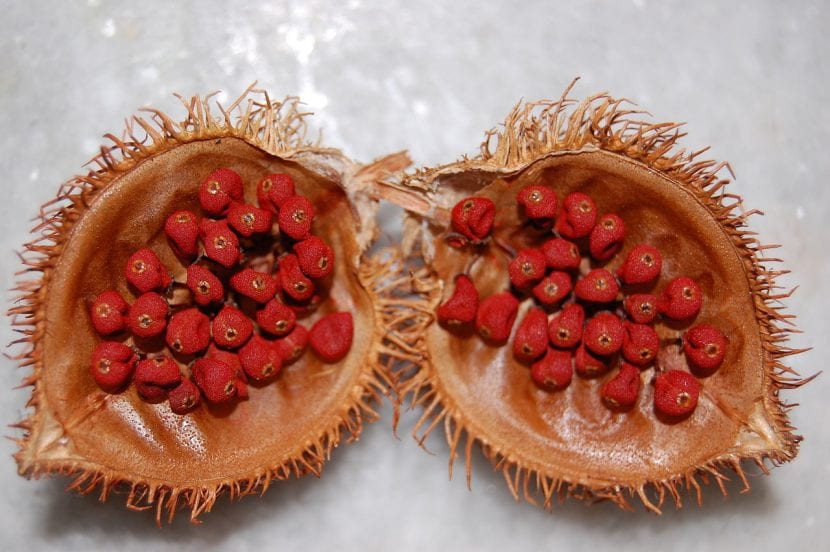
This plant has several uses, as you are going to discover now:
- Culinary: the surface of the seed has a resinous and oily coating that contains a pigment, which is known as annatto. Annatto is used as a food coloring aphrodisiac in the coloring of cheeses such as Cheddar, margarine, butter, rice, smoked fish and sometimes as a condiment in various recipes both from America, the Canary Islands and even Southeast Asia.
- Medicinal: the medicinal properties of achiote are: astringent, antiseptic, antibiotic, antiparasitic, diuretic, antioxidant, expectorant, healing, anti-inflammatory, diuretic, antigonorrheic, febrifuge, stomachic. It can be used against headaches, asthma, inflammations, dyspnea and pleurisy.
- Ground seeds: used to treat measles, smallpox, dysentery, and kidney disease.
- Leaves: used to treat respiratory diseases, kidney pain, fever, bloody vomiting, angina, skin infections, conjunctivitis and skin inflammations.
- Ornamental: it is a very decorative plant that looks great in gardens and patios. Whether as an isolated specimen or in groups, if we live in a warm climate, we can have our green home very well decorated 😉.
What is achiote oil for?
The oil obtained from its seeds is incorporated into creams, creamy lotions, sunscreen and lip balms. Helps restructure hair and protect skin against ultraviolet rays.
Did you know what achiote was and what is it used for?
I see that it is a very nice looking plant, I live in Uruguay so we do not know it, we will see how I can have it, thanks for the information.
Good luck 🙂
Try to also look at websites like ebay, as they sometimes sell.
Greetings.
how is it ingested
Hello, Marcelo.
We recommend consulting with a specialist in medicinal plants, to avoid taking risks.
Greetings.
I was collecting annatto grains, but I did not know how to dry it and for how long. I did this out of curiosity when I came to Cali and that's how I got to know this beautiful plant. Now I'm going to Barranquilla and many seeds were placed in an unpleasant color and I want to take it without having to throw it away.
Hi Liseth.
You can take the seeds with you once they are clean, for example in a tupperware.
Just take them out of the fruit and then put them there 🙂
Regards!
Good afternoon; I need an Achiote root. I live in madrid. They know some place where they have this plant and to be able to get one. .
Thank you very much
Ana Maria
Hello Ana Maria.
Sorry, I know what seeds they sell on amazon or ebay; but roots I can't tell you. Let's see if someone can help you.
Regards!
Fascinated. I had known achiote for between 70 to 80 years and did not know that it was so versatile. I only use it to color the cooking oil (We say it is to make colored rice). Thanks for such an excellent article.
Hello rosa.
Thank you for leaving us your comment 🙂
Greetings.
I loved. I did not know his contributions in the industry. and its importance both in medicinal food and protection of our health
I have planted 3 bushes and they produce many capsules, which has favored me for the daily consumption of food.
I live in Costa Rica and I make a storage room to give away
Hi Hilda.
We are glad to know that it has served you. All the best.